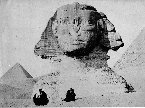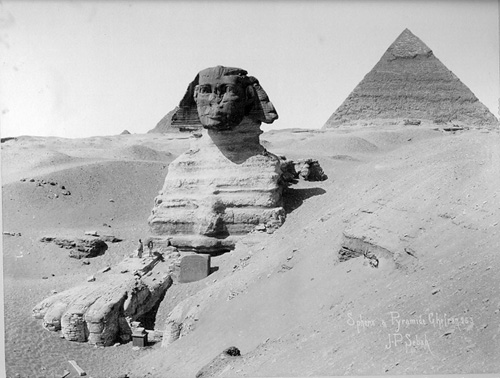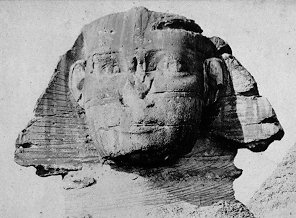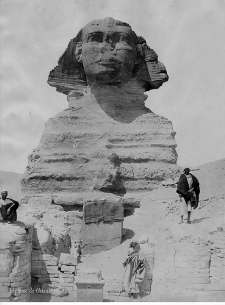The Sphinx - Some History
 Egypt was an arid land before the time of the first Pharaohs. In recent times it has only taken a couple of decades for the Sphinx to be buried up to its neck by sand blown in from the desert, as can be seen in this photo from the 19th Century. Ancient and historical records indicate that its body has been totally covered for long periods of time. Egypt was an arid land before the time of the first Pharaohs. In recent times it has only taken a couple of decades for the Sphinx to be buried up to its neck by sand blown in from the desert, as can be seen in this photo from the 19th Century. Ancient and historical records indicate that its body has been totally covered for long periods of time. |

Photos courtesy of the Middle East Department,
Joseph Regenstein Library, The University of Chicago.
Here is some historical information relevant to the Sphinx and its origins:
- Predynastic Egypt (before the Pharoahs) - great numbers of half-man half-lion amulets were found from this archaeological period.
- First Dynasty - ivory labels from tombs at Abydos show a large Sphinx half buried, with only head and paws visible. On these images the head is large but the face indistinct.
- Old Kingdom (approximately 4500 - 5000 years ago) - extensive restoration work was done on the Sphinx with large limestone blocks and plaster and some portions were recarved - the toes and possibly the head.
- New Kingdom - further brickwork restorations
- Ptolemaic period (2nd Century BC) - section of flanks built up with stonework
- Roman period (Marcus Aurelius)- section of flanks further built up with smaller stonework and square 'fire pits' constructed on either side.
- Roman period - A small altar of red aswan granite from another structure at Giza was moved to a position between the paws.

Photo courtesy of the Middle East Department,
Joseph Regenstein Library, The University of Chicago. |
- In 1379 - as reported by the Arab author Al Maqrizi - a man by the name of Saim el Dahr hacked off the monument's nose.
- Medieval and renaissance visitors took pieces of the Sphinx's headress and face as talismans and remedies.
- During the 17th and 18th centuries, invading Marmalukes and French soldiers reportedly used the head for target practice.
|
|

Photo courtesy of the Middle East Department,
Joseph Regenstein Library, The University of Chicago. |
Between the paws
In the early photo, the deterioration is clearly visible. The recent photo shows the extensive restorations done around the neck and edges of the headress. The bulge of rock on the chest is all that remains of what may have once been a smaller sculpted figure.
|
|
The 'Stella' (that dark rectangular monument) between the paws and in front of the chest was erected during the brief reign of Thothmoses IV (1420-1411 BC). When first excavated, it had a partially eroded hieroglyphic phrase near the bottom which included a syllable in the name Khafre. It was translated as "praise to Un-nefer...Khafre...the statue made for Atum-Harmakhis". Many Egyptologists accept this as evidence that Khafre built the Sphinx. Others disagree. Some time after it was excavated, the particular inscription in question flaked off and we now have only drawings.
The age of the Sphinx is still being hotly debated and as yet there appears to be no evidence conclusive enough to settle the question.
- Pharaoh Amenhotep II (1448-1420 B.C.) mentioned the Sphinx as being older than the Pyramids.
- On the 'Inventory Stele' found by Auguste Mariette in 1857, the inscription describes how Pharaoh Khufu (prior to Khafre) endeavoured
to excavate and restore the Sphinx.
- "This marvelous object was in existence in the days of Khafre, or Khephren, and it is probable that it is a very great deal older than his reign and that it dates from the end of the archaic period."
-E.A. Wallis Budge (then Keeper of the Egyptian Antiquities in the British Museum) 'The Gods of the Egyptians', 1904
- " The Sphinx stela shows, in line thirteen, the cartouche of Khephren. I believe that to indicate an excavation carried out by that prince, following which, the almost certain proof that the Sphinx was already buried in sand by the time of Khafre and his predecessors." - Gaston Maspero - surveyed the Sphinx in the 1920's
- "Excepting for the mutilated line on the granite stela of Thothmothis IV, which proves nothing, there is not a single ancient inscription which connects the Sphinx with Khafre" - Selim Hassan
'The Sphinx, Its History in the Light of Recent Excavations', 1949
- J.H. Breasted - commenting on the opinion that the stela inscription supported the thesis that Khafre was the builder "a conclusion which does not follow."
- Carbon 14 dating analysis on a single mortar sample from between two blocks in the Sphinx Temple produced two different dates from two different laboratories: one of 2086 B.C. and one of 2746 B.C. in a research project conducted by Mark Lehner in 1985-86.
|
Modern Egyptology text books link the construction of the Sphinx to the 4th dynasty Pharaoh Khafre. Alternate theories continue to be put forth, mostly from outside academic Egyptology or Archaeology.
Index |
Page 1 |
Page 2 |
Page 3
|